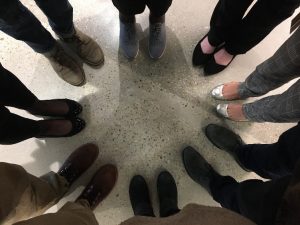Jan 14, 2020

A while ago, my colleagues and I invited the people in our training to imagine they were someone they were not. For a while they had to “be” this person and experience the joys and challenges of this role. They had to put themselves in someone else’s shoes and look from a different perspective.
This experience was mind-opening!
You have to understand, I work for International Budget Partnership, and my colleagues and I conduct trainings on the research methodology of the Open Budget Survey. We work with government officials in countries around the world and discuss budget transparency and accountability in the hope that these government representatives will contribute to the Survey’s research process. These groups are not often invited to engage with content or each other in ways like “putting yourself in someone’s shoes.”
This technique was very helpful, so let me tell you how it worked.
The task for one session of the workshop was straightforward enough: to discuss the key information that a budget proposal – the document that a government executive prepares each year as the basis for debating about policy priorities and allocating budgets – should contain. The challenge was to explore this with participants – government officials with a high level of knowledge about the topic – in a way that would contribute to their understanding of what budget information is relevant from the perspective of civil society and why. We decided to try something new.
As with the Pick a Spot Technique, the tool of putting yourself in someone else’s shoes helps to bring constructive insights and transformative learning.
Here’s how it works:
- Set the parameters of discussion. Ask participants to step out of their status (e.g., work position) and put themselves in the shoes of a different group/person. In our case, we asked the government participants to imagine themselves as a researcher in a civil society organization.
- Allow for questions and clarifications. Some participants may wonder whether they should assume for the purpose of the exercise that they have the same knowledge and experience they currently have. Some may struggle with the idea of being part of a different organization or setting. And some may find it quite exciting to look at the topic through a different lens.
- Allow a few minutes for people to consider their ideas. Encourage a focus on what is relevant from the other person’s point of view.
- Open the discussion for sharing thoughts on the content discussed. In our case, we asked government officials to share their thoughts about what information they wanted to see in a budget proposal to be able to analyze it.
- Provide time for sharing the challenges of the task to ensure participants feel respected and recognize that putting themself in someone else’s shoes is about understanding the needs of others and empathizing with them. You can pose some questions such as:
- Why do you think the group you whose perspective you are currently imagining has a given point of view?
- What do you find challenging from that point of view?
- What limits your ability to put yourself in those shoes?
- What could you do in your real position to better work for someone else’s needs?
- Wrap up by collectively discussing what has been learned during the exercise. For example, in our session most participants recognized the need to see the other party as equal to them.
Times to consider using this technique include:
- For a warm-up: Asking people to think from a different perspective gives the facilitator or trainer an initial idea on where people stand on a given topic.
- At the start of a large activity or period of work: It allows participants to bring different ideas and anchor a more in-depth discussion from the point of view of an organization or group they are not part of. It can also invite feelings of empathy and interest when a person or group’s situation is better understood.
The approach of “putting yourself in someone else’s shoes” can be extremely helpful. Whether in a learning event or meeting, it can generate insightful discussions, break down silo thinking, and create new understanding.
What techniques do you use to open up thinking and dialogue?
María José Eva joined IBP in October 2016 and is based in Washington D.C. She is a Program Officer leading IBP’s work on the Open Budget Survey in Latin America and the Caribbean. Prior to joining IBP, María José worked extensively on human rights, development and public policy as a researcher for Amnesty International in London and the Center for Economic and Social Rights in Madrid. María José also previously taught international human rights law, practiced private law and worked as a researcher for the Center for Human Rights at the University of Chile. She has a law degree from the University of Chile and holds an MPA in Public and Economic Policy from the London School of Economics.
Note: Photo taken by María José with the help of some of her colleagues.
Other blog posts on facilitation you might find interesting:



